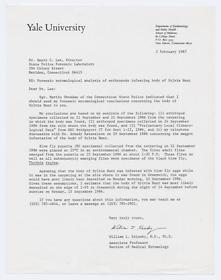Dr. Krinsky's findings, Sylvia Hunt case, February 2, 1987
A letter to the State Police Forensic Laboratory detailing Dr. Krinsky's conclusions. Note that he takes into consideration climatological data, the body's position and degree of exposure, and insect species. He also does not provide an estimate of time of death, but rather of the time when the body was deposited at the site.
Courtesy of William L. Krinsky, M.D., Ph.D.
Image 3 of 10
Insect testimony
On September 21, 1986, the decomposing body of a 26-year-old woman was found inside a foul-smelling carpet near I-95 in Greenwich, Connecticut. Blow fly larvae were feeding on, and moving in and around, the body. Pale and dark brown blow fly puparia were recovered, along with 4,000 larvae, for laboratory study.
An autopsy revealed that the victim, Sylvia Hunt, had been stabbed 15 times. Forensic entomologist William Krinsky determined from climate and insect evidence that blow flies had deposited eggs on the corpse seven days earlier. The carpet pattern matched one in the room occupied by a suspect. The insect and carpet evidence helped convict him of first-degree murder.
